Comments / Questions (259)
![]() Mamieflo wrote:
Mamieflo wrote:
Je recommence, je ne vois pas mon commentaire . Un modèle très chou que j'ai tricoté pour mon 11eme petit-enfant pour sa naissance, offert à la maternité. Je ne l'ai pas vu sur lui mais sur une poupée de sa sœur. Un peu déçue, je ne sais pas s'il l'a porté car petit il porte des grenouillères. Un modèle simple à tricoté, joli dans les coloris proposés. J'ai pris autre chose pour la bordure, ce que j'avais.
03.03.2018 - 18:29
![]() Christine Owen wrote:
Christine Owen wrote:
I'm a bit confused as to how to attach the left and right front pieces at the neck. After working the left front piece back onto the circular needle and casting on stitches for the back, then working the right front piece onto the circular needle, how do I attach the pieces?
18.01.2018 - 17:25DROPS Design answered:
Dear Mrs Owen, work sts from left front piece, then cast on the new sts for neck (see video and work the sts from right front piece = all sts are now on the same needle with new sts for neck inbetween. Happy knitting!
19.01.2018 - 10:40
![]() Riejan Smits wrote:
Riejan Smits wrote:
Kan dit vstje ook op gewone naalden worden gemaakt?
17.11.2017 - 17:31DROPS Design answered:
Hallo Riejan, In plaats van rondbreinaalden zou je inderdaad prima rechte naalden met knop kunnen gebruiken bij dit patroon. Maar met name bij de grote maten heb je dan op een gegeven moment veel steken op de naald (meer dan 100) omdat het met aangebreide mouwen is. Dit is even iets om rekening mee te houden.
20.11.2017 - 15:04Frank Dinucci wrote:
Do you have any video of that? I'd want to find out some additional information.
14.11.2017 - 18:54DROPS Design answered:
Dear Mrs Dinucci, you will find the videos related to the techniques used in that pattern under tab "video" or at the bottom of the page (scroll down until after measurement chart). Should you have any further question you are welcome to ask here or contact the store where you bought your yarn. Happy knitting!
15.11.2017 - 08:44
![]() Lena wrote:
Lena wrote:
Hej, jag är nybörjare. Frågan gäller höger framstycke. Då jag ska göra minskningar, ska jag samtidigt lägga upp maskor till ärm, och samtidigt lägga upp 2 nya maskor mot hals. Förstår inte alls hur jag ska göra? Vore mycket tacksam hjälp :)
26.09.2017 - 09:59DROPS Design answered:
Då man lägger upp nya maskor till ärmen kommer detta att ske samtidigt med att man minskar för halsen. De nya maskorna mot halsen läggs upp först då arb mäter (20) 24-28-30-32 (36-40) cm, så detta görs först efter att alla maskor lagts upp för ärmen.
26.09.2017 - 14:31
![]() Susanne wrote:
Susanne wrote:
Hallo. Ich habe das rechte Vorderteil fast fertig. In Ihrer Beschreibung schreiben Sie, dass nach den letzten Zu- und Abnahmen weiter kraus re zu stricken ist, bis zu einer Höhe von 24 cm. Stricke ich jetzt auf 24cm Höhe und nehme dann nochmal für den Halsausschnitt zu oder nehme ich gleich 2x2 Maschen zu und stricke dann bis zur angegebenen Höhe? Vielen Dank für Ihre Antwort. Viele Grüße ~Susanne~
23.08.2017 - 15:46DROPS Design answered:
Liebe Suzanne, wenn Sie die 52 M haben, stricken Sie bis 24 cm, und dann nehmen Sie für den Halszauschnitt zu (= 56 M). Viel Spaß beim stricken!
28.08.2017 - 12:39
![]() Annie wrote:
Annie wrote:
Hi - please breakdown the instructions for the crochet edging - I can't seem to follow the 2nd row. what do the "+" signs mean? "skip 1 sc + 1 ch + 1 sc, work 1 sc in next ch " also, do you mean that only the second row sequence needs to be worked for the sleeves?
05.07.2017 - 22:07DROPS Design answered:
Dear Annie, the + means that you should leave out a unit made up from (1 dc and 1 ch and 1 dc) and then you crochet a slip stitch into the next chainstitch. I hope this helps. Happy Crochet!
06.07.2017 - 00:39Cuquita wrote:
Hola, gracias por la página del glosario. Quisiera saber si tienes otra de significado de abreviaturas. Gracias
04.07.2017 - 17:27DROPS Design answered:
Hola Cuquita. Puedes consultar tus dudas en el apartado Tips y Ayuda: https://www.garnstudio.com/school.php?cid=23
09.07.2017 - 18:10Cuquita wrote:
Hola, he terminado el primer patrón delantero, pero no entiendo que es insertar 1 MP en en el escote del cuello. Creo que seria interesante que pusieran un glosario de abreviaturas para poder entenderlas. Gracias
27.06.2017 - 03:03DROPS Design answered:
Hola Cuquita. Aquí puedes consultar el glosario: https://www.garnstudio.com/glossary.php?langf=es&langt=en. No encuentro tu frase exactamente en el patrón, pero quiere decir que para marcar desde donde tenemos que medir la labor a partir de este momento hay que colocar un marcapuntos en la fila que forma la linea del escote.
01.07.2017 - 18:16
![]() Annie wrote:
Annie wrote:
Bedtime Stories: Hi ! I just finished sewing up the seams on the cardigan and noticed that when I lay it flat and cross the front pieces over each other, the sleeves do not lay flat. Rather, the under seam on the sleeves curl up towards the front of the sleeve. Did I do something wrong? Is there a way to correct this? Will blocking help?
26.06.2017 - 18:38DROPS Design answered:
Dear Annie, always make sure that the stitching is not to thight, when you sew up seems, as this can pull it up. Try to sew up more loosely, that is do not pull the stitches very thight. Blocking also might help, to a certain degree. Happy Knitting!
27.06.2017 - 01:36
Bedtime Stories#bedtimestoriescardigan |
|
 |
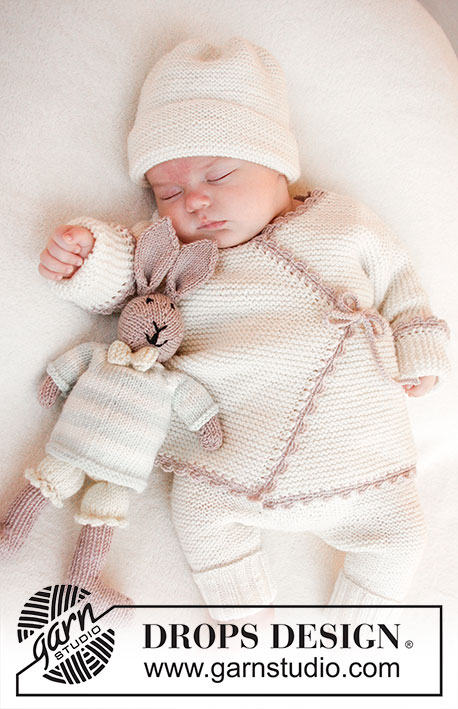 |
Knitted wrap cardigan in garter st and crochet edge for baby in DROPS BabyMerino. Size premature - 4 years
DROPS Baby 25-11 |
|
|
GARTER ST (back and forth on circular needle): K all rows. DECREASE TIP: Dec inside 1 edge st in garter st. All dec are done from RS! Dec after 1 edge st as follows: Slip 1 st as if to K, K 1, psso. Dec before 1 edge st as follows: K 2 tog. ---------------------------------------------------------- CARDIGAN: Worked back and forth on circular needle. Beg on front piece, cast on sts for sleeve and work up to the shoulder. Work the other front piece, place both front pieces tog and work down the back piece. RIGHT FRONT PIECE: LOOSELY cast on (34) 37-44-48-52 (55-62) sts on circular needle size 3 mm with off white and work in GARTER ST - see explanation above (1st row = RS). READ ALL OF THE FOLLOWING SECTION BEFORE CONTINUING! When piece measures (9) 12-16-16-17 (20-23) cm (adjust so that next row is worked from RS), dec 1 st for neck inside 1 edge st at beg of row - READ DECREASE TIP. Repeat dec on every other row (i.e. every row from RS) (17) 17-21-23-25 (27-31) more times (= (18) 18-22-24-26 (28-32) dec in total), then dec every 4th row (i.e. every other row from RS) 2 times in total. AT THE SAME TIME when piece measures (12) 15-19-20-21 (24-27) cm cast on new sts at the end of row towards the side of sleeve as follows: (3) 4-6-6-6 (6-6) sts (4) 4-4-5-6 (7-8) times in total and then (16) 19-19-18-19 (23-26) sts 1 time. After all inc and dec there are (42) 52-63-70-79 (90-102) sts on the needle for shoulder/sleeve. Continue in garter st until piece measures (20) 24-28-30-32 (36-40) cm / (8”) 9½”-11”-11¾”-12½” (14¼”-15¾”). Insert 1 marker in the middle sts = mid on top of shoulder. Piece is measured from here – AT THE SAME TIME cast on 2 new sts at the end of row towards the neck, repeat inc on next row towards neck = (46) 56-67-74-83 (94-106) sts (last row = WS). Put all sts on a stitch holder. LEFT FRONT PIECE: Cast on and work as right but reversed (i.e. dec for neck inside 1 edge st at the end of row from RS (instead of at the beg of row from RS). In addition K 1 row from WS at the end of front piece after casting on sts towards the neck so that last row on both right and left front piece is worked from WS. BACK PIECE: Work left front piece on to circular needle (= K from RS), cast on (8) 8-10-10-12 (14-16) new sts (= back of neck) and work right front piece on to circular needle (= K from RS) = (100) 120-144-158-178 (202-228) sts. NOW MEASURE PIECE FROM MARKERS ON SHOULDERS. Continue to work in garter st back and forth on needle. When piece measures (6) 7-7-7½-8 (9-9) cm, cast off sleeve sts as follows: Cast off at beg of every row in each side as follows: (16) 19-19-18-19 (23-26) sts 1 time and (3) 4-6-6-6 (6-6) sts (4) 4-4-5-6 (7-8) times in total = (44) 50-58-62-68 (72-80) sts on needle. Continue until piece measures approx. (20) 24-28-30-32 (36-40) cm – fold piece at the markers on shoulders and check that front and back pieces are the same length – loosely cast off. ASSEMBLY: Sew side and sleeve seams tog edge to edge in front loop of outermost sts. CROCHET EDGE: Work on hook size 2.5 mm with light beige around the entire opening on cardigan as follows: ROUND 1: 1 dc in first st, * 1 ch, skip approx. 2 sts, 1 dc in next st *, repeat from *-* but in a corner where dec for neck beg work tie as follows: 1 dc in tip, then work ch for approx. 20-25 cm, turn and work 1 sl st in every ch on return, then work 1 dc in tip of front piece again, continue crochet border around the cardigan until the tip of the other front piece, crochet another tie as on first front piece, continue around the rest of the cardigan and finish with 1 sl st in first dc from beg of round. ROUND 2: 1 dc in first ch, * 4 ch, 1 tr in 4th ch from hook, skip 1 dc + 1 ch + 1 dc, work 1 dc in next ch *, repeat from *-* the entire round (make sure to work over ties so that they are at the bottom), finish with 1 sl st in first dc from beg of round. Work both rounds the same way at the bottom around both sleeves. Then work another tie, similar to the one in each tip, on the inside of the seam in the right side and on the outside of the seam in the left side – make sure that the ties are at the same height as tips on front pieces. |
|
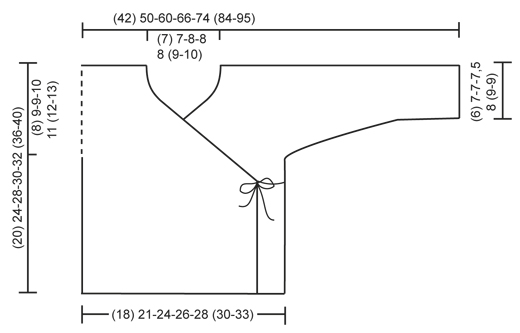 |
|
Have you finished this pattern?Tag your pictures with #dropspattern #bedtimestoriescardigan or submit them to the #dropsfan gallery. Do you need help with this pattern?You'll find 19 tutorial videos, a Comments/Questions area and more by visiting the pattern on garnstudio.com. © 1982-2025 DROPS Design A/S. We reserve all rights. This document, including all its sub-sections, has copyrights. Read more about what you can do with our patterns at the bottom of each pattern on our site. |
|







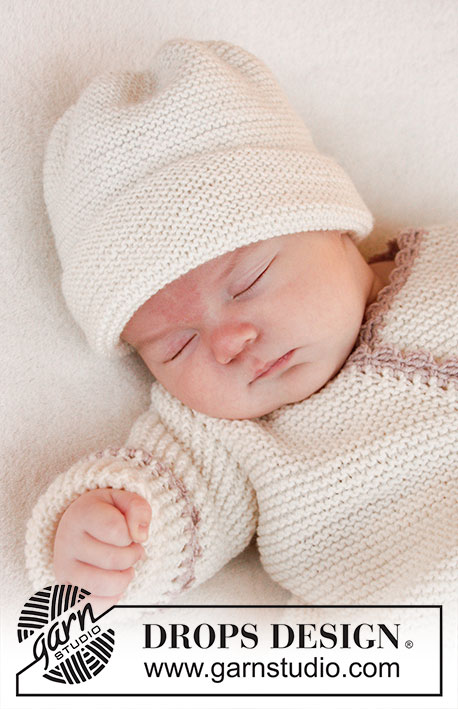

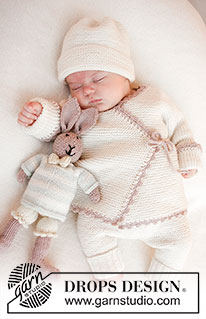
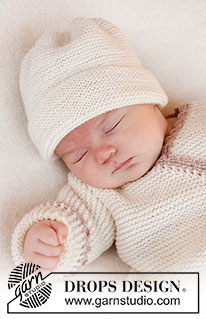

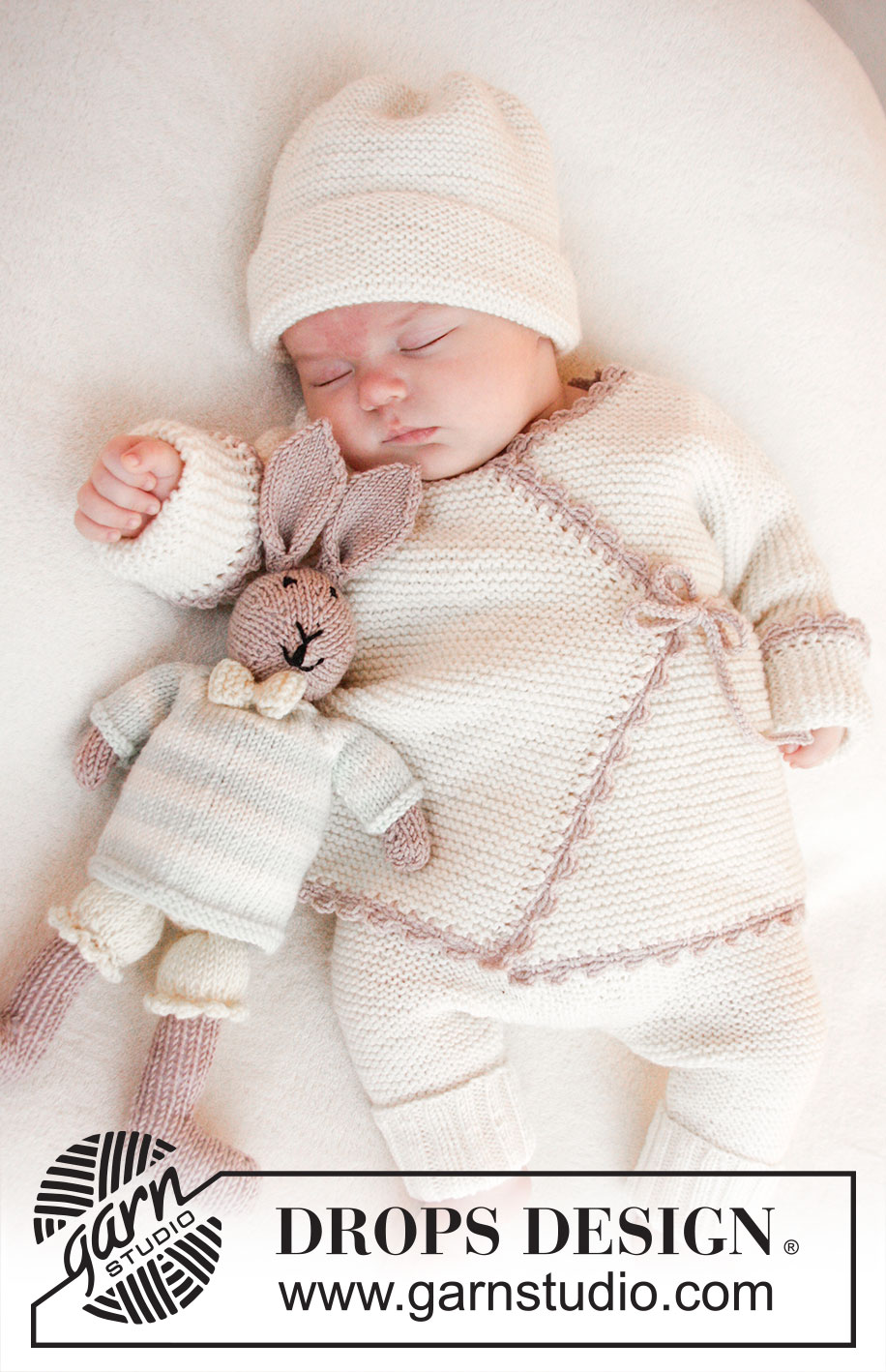
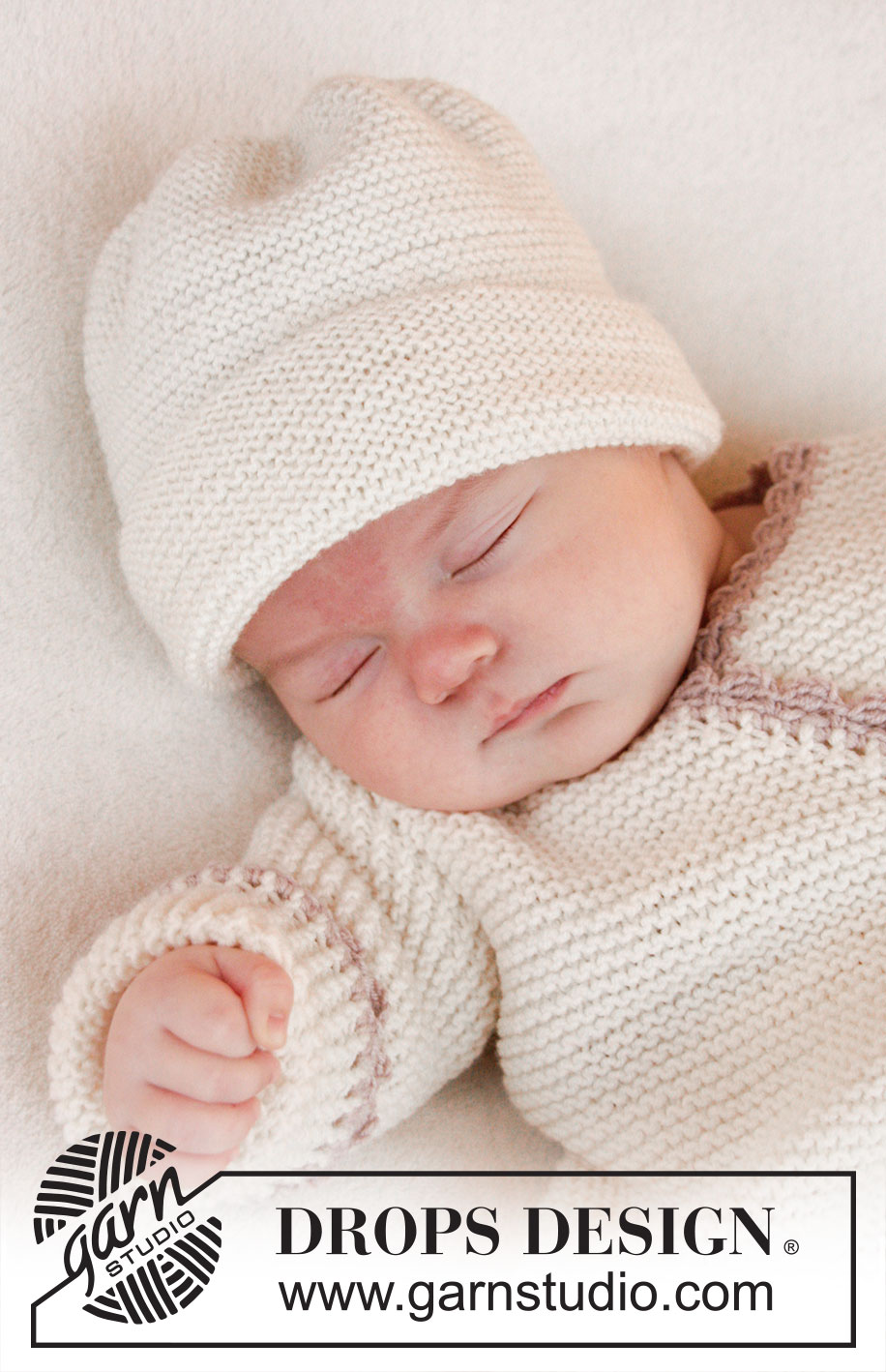


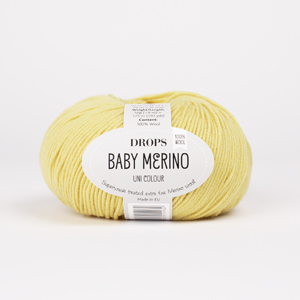
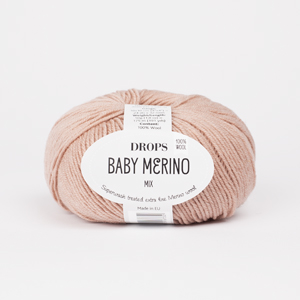








































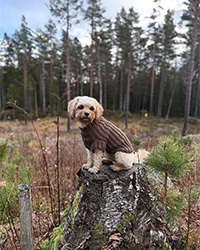
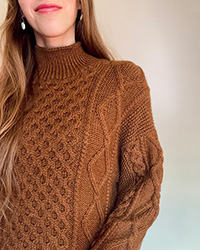
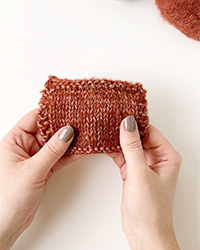
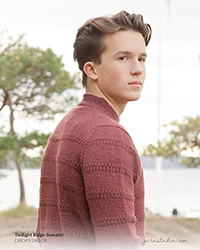
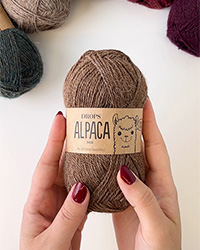
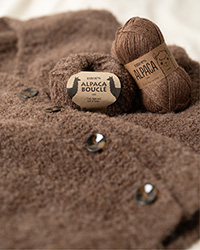
Post a comment to pattern DROPS Baby 25-11
We would love to hear what you have to say about this pattern!
If you want to leave a question, please make sure you select the correct category in the form below, to speed up the answering process. Required fields are marked *.